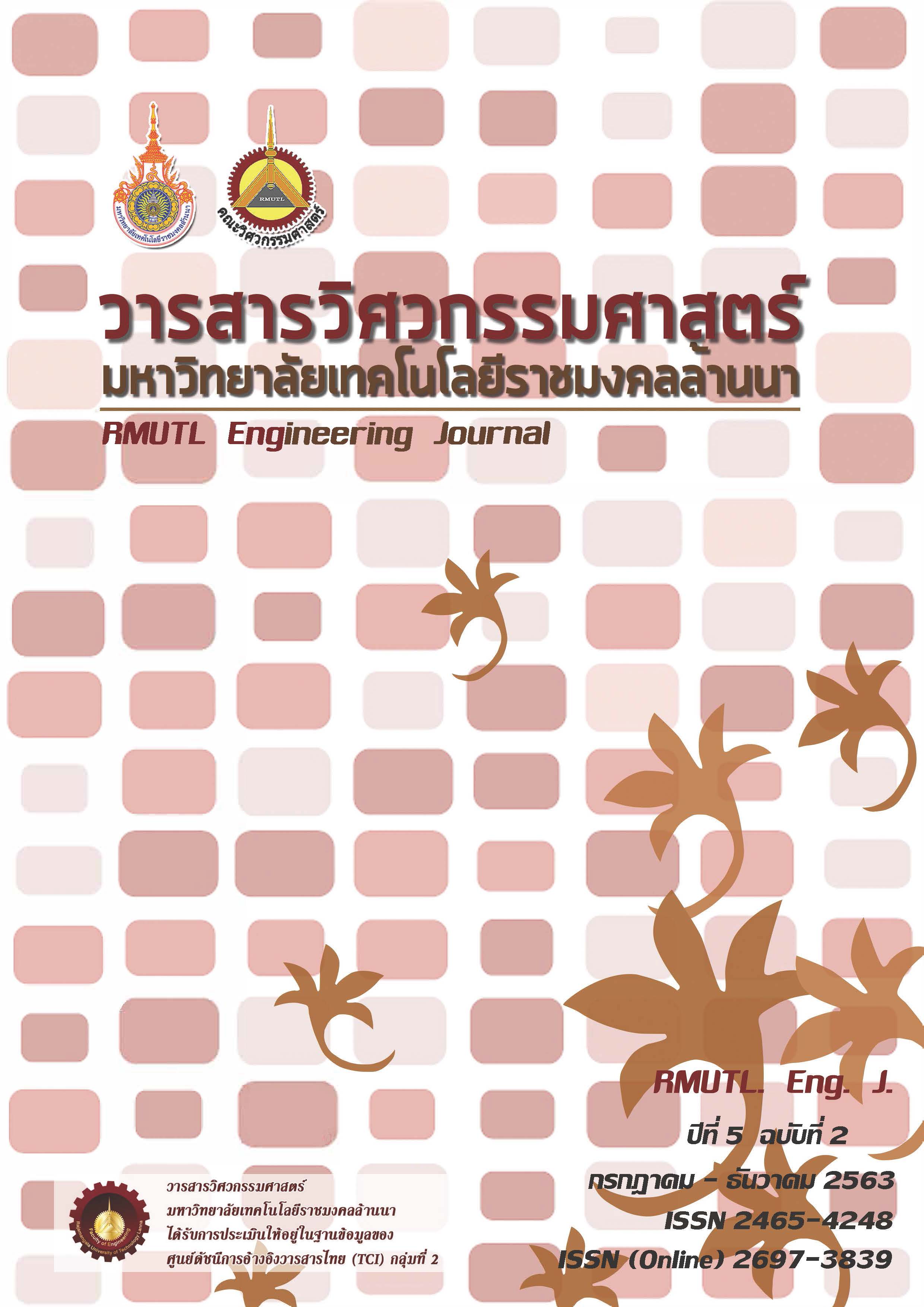Utilization of Lateritic Soil as Coarse Aggregate in Concrete for Artificial Aquifer
DOI:
https://doi.org/10.14456/rmutlengj.2020.12Keywords:
Artificial Aquifer, Lateritic Soil as Coarse Aggregate, Rice Husk Ash, Water Absorption, Infiltration RateAbstract
This paper presents a laboratory study on the suitability of using lateritic soil as coarse aggregate in pervious concretes as artificial aquifer. Two sizes of laterite available in Prince of Songkla University Hat Yai campus, 9.5-25.0 mm and 25.0-37.5 mm in size, were used as the coarse aggregates. The mixture contained ordinary Portland cement Type 1 (OPC), lateritic aggregate, and sand in proportion of 1:2:1.25 by weight and the OPC was partially replaced with ground rice husk ash in proportion of 15wt.%. All of the samples were casted in size of 100×100×100 mm and the bulk density, water absorption, Infiltration rate, Shore hardness and compressive strength after curing for 1, 7 and 28 days were determined. The mineral phases and microstructure were analyzed via X-ray diffraction (XRD) and scanning electron microscope (SEM) techniques, respectively. Experimental results showed that the laterite coarse aggregate of size 25.0-9.5 mm and concrete cured for 28 days provided compressive strength of 18 MPa, water absorption of 30.57% and infiltration rate of 0.15-0.37 m3/min/m2. The XRD pattern revealed mineral phases abundant of ettringite and calcite. SEM displays interfacial transition zone. The lateritic aggregate concrete was found to be a satisfactorily shallow artificial unconfined aquifer.
References
2.Ryduchowska DT. The effect of aggregate variation on the compressive strength of laterite concrete. Cem. Concr. Res. 1986; 16(2):135-142.
3.Falade FA. Comparative study of normal concrete with concretes containing granite and laterite fine aggregates. SEMC. 2001;2:1407-1413.
4.Udeoyo FF, Iron UH, Odim OO. Strength performance of laterized concrete. Constr Build Mater. 2006;20(10):1057-1062.
5.Ettu LO, Ibearugbulem OM, Ezeh JC, Anya UC. The suitability of using laterite as soil fine aggregate in structural concrete. IJSER. 2013;4(5):502-507.
6.Muthusamy K, Kamaruzaman NW, Ahmad SW, Yahaya FM. Study on durability performance of concrete containing laterite aggregates. Concr Res Lett. 2015;6(2):60-68.
7.Raheem AA, Bello OA, Makinde OA. A comparative study of cement and lime stabilized lateritic interlocking blocks. PJST. 2010;11(2):27-34.
8.Otoko GR, Isoteim F–M, Oyebode OJ. The suitability of lateritic soils for block making. IJMER. 2016;6(9):12-16.
9.Tonnayopas D, Hnumuang K and Nounpradit T. Effect of cement clinker dust on stabilized lateritic soil. Proceedings of the 9th Mining, Metallurgical and Petroleum Conference (REUSE II), 2011 Jan 13-14; Montien Riverside Hotel, Bangkok: 2011. p. 183-190.Thai.
10.Tonnayopas D, Thinpakpanang T. Improvement of clay soil with industrial wastes. Engng.J.CMU. 2015;22(1):1-8.Thai.
11.Awoyera PO, Dawson AR, Thom NH, Akinmusuru JO. Suitability of mortars produced using Laterite and ceramic wastes: Mechanical and microscale analysis. Constr Build Mater. 2017;148:195-203.
12.Mathew G, Paul MM. Mix design methodology for laterized self-compacting concrete and its behavior at elevated temperature. Constr Build Mater. 2012;36:104–109.
13.Ministry of Natural Resources and Environment. Environmental management from the use of lateritic soil and soft rock (South Region). The Office of Natural Resources and Environmental Policy and Planning, Thailand. Final Report: 2014.Thai.
14.American Concrete Institute. ACI 522.1-13. Specification For pervious concrete pavement. USA; ACI Committee; 2013.
15.Tonnayopas D, Jitnukoon K. Effect of Sang Yod rice husk ash on Songkhla Lake gravel gap-graded aggregate concrete. SWU Eng. J. 2013; 8(2):62-69. Thai.
16.American Society for Testing and Materials. ASTM C136/C136M-14. Standard test method for sieve analysis of fine and coarse aggregates. PA: ASTM International; 2014.
17.British Standards Institution. BS 812-105.2:1990. Testing aggregates. Methods for determination of particle shape. –Section elongation index of coarse aggregate. London: BSI; 1990.
18.British Standards Institution. BS EN 933-3:2012. Tests for geometrical properties of aggregates. Determination of particle shape. Flakiness index. London: BSI; 2012.
19.American Society for Testing and Materials. ASTM C29/C29M-17a. Standard test method for bulk density (“Unit Weight”) and voids in aggregate. PA: ASTM International; 2017.
20.British Standards Institution. BS EN 1097-3:1998. Tests for mechanical and physical properties of aggregates –Part 3: Determination of loose bulk density and voids. London: BSI; 1998.
21.American Society for Testing and Materials. ASTM D4644-16. Standard test method for slake durability of shales and other similar weak rocks. PA: ASTM International; 2016.
22.American Society for Testing and Materials. ASTM C131/C131M-20. Standard test methods for resistance to degradation of small-size coarse aggregate by abrasion and impact in the Los Angeles machine. PA: ASTM International; 2020.
23.American Society for Testing and Materials. ASTM C1754/C1754M-12. Standard test method for density and void content of hardened pervious concrete, PA: ASTM International; 2012.
24.American Society for Testing and Materials. ASTM C1781/C1781M-18e1. Standard test method for surface infiltration rate of permeable unit pavement systems. PA: ASTM International; 2018.
25.American Society for Testing and Materials. ASTM F1957-99(2017), Standard Test Method for composite foam hardness-durometer hardness. PA: ASTM International; 2017.
26.American Society for Testing and Materials. ASTM C109/C109M-16a. Standard test method for compressive strength of hydraulic cement mortars (Using 2-in. or [50-mm] cube specimens). PA: ASTM International; 2016.
27.Indian Standard (IS), Indian Road Congress (IRC), BIS and Ministry of Road Transport and Highway (MORTH).
28.Franklin JA, Chandra R. The slake-durability test. Int J Rock Mech Min Sci Geomech Abstr. 1972; 9(3):325-328.
29.Muthusamy K, Kamaruzaman NW. Assessment of Malaysian laterite aggregate in concretes. IJCEE. 2012;12(4):83-86.
30.Ogundipe OM, Olanike AO, Nnochiri ES, Ale PO. Effects of coarse aggregate size on the compressive strength of concrete. C.E.J. 2018;4(4):836-842.
31.Olugbenga A. Effects of varying curing age and water/cement ratio on the elastic properties of laterized concrete. Civ. Eng. Dimens. 2007;9(2):85-89.
32.Yu Q, Sawayama K, Sugita S, Shoya M, Isojima Y. The reaction between rice husk ash and Ca(OH)2 solution and the nature of its product. Cem. Concr. Res. 1999:29(1):37-43.
33.Min D, Tang M. Formation and expansion of ettringite crystals.Cem. Concr. Res. 1994:24(1):119-126.
34.Bizzozero J, Gosselin C, Scrivener KL. Expansion mechanisms in calcium aluminate and sulfoaluminate systems with calcium sulfate Cem. Concr. Res. 2014:56:190-202.










